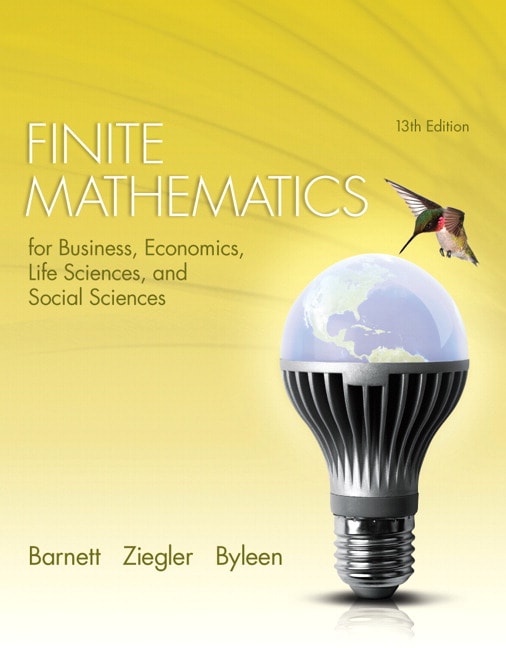Finite Mathematics Eighth Edition
Following the table of contents in Finite Mathematics 7e. Stefan Waner and Steven R. Costenoble You can get back here from anywhere by using the Everything for Finite Math link. Note: To change the edition of the book, use the navigation on the top left.
Download Product FlyerDownload Product Flyer
Description
Related Resources


Instructor
Contact your Rep for all inquiries
Finite Mathematics 6th Edition Answers
Table of contents
Chapter 1. Linear Equations.Chapter 2. Systems of Linear Equations; Matrices.
Chapter 3. Linear Programming: Geometric Approach.
Chapter 4. Linear Programming: Simplex Method.
Chapter 5. Finance.
Chapter 6. Sets; Counting Techniques.
Chapter 7. Probability.
Chapter 8. Additional Probability Topics.
Chapter 9. Statistics.
Chapter 10. Functions and Their Graphs.
Chapter 11. Classes of Functions.
Chapter 12.The Limit of a Function.
Chapter 13. The Derivative of a Function.
Chapter 14. Applications: Graphing Functions; Optimization.
Chapter 15. The Integral of a Function and Applications.
Chapter 16. Download who wants to be a millionaire apk for windows 10. Other Applications and Extensions of the Integral.

Chapter 17. Calculus of Functions of Two or More Variables.
Appendix A: Review.
Appendix B: Using LINDO to Solve Linear Programming Problems.
Appendix C: Graphing Utilities.
Answers to Odd-Numbered Problems.
Photo Credits.
Index.
New To This Edition
New Features:- NEW! Full-color design improves clarity and assists student understanding with consistant pedagogical use of color.
- More applications using real data enhances student motivation. Many of these applications include source lines, to show how mathematics is used in the real world.
- NEW! Conceptual problems ask students to put the concepts and results into their own words. These problems are marked with an icon to make them easier to assign.
- Preparing for this Section features guide the student on which concepts to review before starting each new section.
- Each section begins with a set of objectives, which are highlighted and maintained throughout the section. At the end of each chapter, these objectives are reviewed, with specific Review Exercises to test the student's command of the material.
- Each chapter ends with a Chapter Project that can be used in class, assigned for homework, or employed for group work.
- NEW! Use of Excel Spreadsheets are now integrated throughout.
Extra
Features
Hallmark Features:- More opportunities for the use of graphing calculator, including screen shots and instructions.
- Icons clearly identify each opportunity for the use of spreadsheets or graphing calculator.
- Now Work problems appear throughout the text, giving the student the chance to immediately reinforce the concept or skill they have just learned.
- Chapter Reviews contain a variety of features to help synthesize the ideas of the chapter:
- Important Terms and Concepts
- Fill in the Blanks
- Mathematical Questions from Professional Exams (CPA)
Sample questions asked in the 8th edition of Finite Mathematics:
Data from the U.S. Bureau of Labor Statistics indicate that, for Americans under the age of 35, 40.6% almost always pay off the balance of their credit card bills, 24.1% sometimes pay off the balance, and 35.4% hardly ever pay off the balance.
In Exercise, the amount (future value) of an ordinary annuity is given. Find the periodic payments. A = $14,500, and the annuity earns 6% compounded monthly for 10 years.
Baylor University purchased a financial systems software package and converted all budget identification numbers to a 15-character identification code. Each character in the identification code can be any one of the 26 letters of the alphabet or any one of the digits 0 through 9. (a) How many different budget numbers are possible in this system? (b) If the Budget Office assigns 1 million budget numbers each second, 24 hours a day for every day in the year, how long will it take to use up all the budget numbers?
(See Example 8) Two people are randomly selected from a group of 4 men and 4 women. The random variable X is the number of men selected. Find the probability distribution for X and its graph.
A linear programming problem seeks to maximize z = Ax+ By, subject to 5 x + 2 y ? 240 2 x+ 3 y ? 140 x ? 0, y ? 0 0 Find the range of slopes of the objective function z = Ax + By so that the maximum occurs at (48, 0).
Find the feasible regions of the systems of inequalities in Exercise. Determine the corners of each feasible region. 2 x + y ? 8 10 x + y ? 20 x ? 0, y ? 0